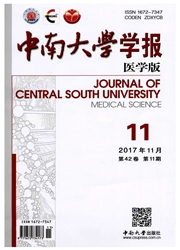

 中文摘要:
中文摘要:
目的:明确变性真皮的病理特性,自体皮移植后的病理过程及转归。方法:将SD大鼠背部制成直径2.5cm的深Ⅱ度烧伤创面,简单清创,异体皮覆盖创面48h后,浅削痂保留变性真皮,局部移植大张自体断层皮片,植皮后不同时间切取植皮区全层皮肤,HE,Masson’s染色观察变性真皮与移植皮片的病理变化情况。结果:浅削痂后可见变性真皮上层存在较多坏死细胞,仅有少量活性细胞,胶原变性,并伴随大量炎性细胞浸润;植皮后早期仍然可见变性真皮内坏死组织,炎性细胞,植皮后3d可见断层皮片内存在炎性细胞浸润;10d可见变性真皮内坏死组织明显减少,其表层可见红细胞;21d所植皮片近似正常皮肤。结论:保留变性真皮不影响所植皮片成活,自体皮移植后坏死成分可逐渐吸收,并为新生有活力组织所取代。
 英文摘要:
英文摘要:
Objective To identify the pathological character of denatured dermis, and its turnover after autologous skin transplant. Methods Deep partial thickness burn wounds whose diameter was 2.5 cm were produced on the back of Sprague-Dawley (SD) rats. After simple debriding, xenogenie skin was transplanted. Superficial tangential excision was performed on the burn wounds on 48 hours postburn with the preservation of denatured dermis. Split thickness autologous skin was grafted on the wounds immediately. Tissue samples of whole layer of the skin were harvested from the grafted sites at different time points after the skin grafting. Pathological observation on the denatured skin and the transplanted skin was carried out with HE and Masson' s trichrome blue. Results The superficial cells of the denatured dermis necrotized largely with few cells alive, collagen denatured, and many inflammatory cells infiltrating. Necrosis tissue and inflammatory cells could be found in the denatured skin in the early period after the skin transplant. There were infiltrated inflammatory cells in the transplanted skin 3 days after the skin transplant. On the 10th day, the necrotized tissue diminished markedly, and red cells were found in its upper stratum. On the 21 st day, the morphology and structure of the transplanted skin were similar to those of the normal skin. Conclusion The retained de-natured dermis has little effect on the survival of the transplanted skin. The necrosis components can be absorbed and replaced by the tissue alive after the autologous skin is transplanted.
 同期刊论文项目
同期刊论文项目
 同项目期刊论文
同项目期刊论文
 期刊信息
期刊信息
